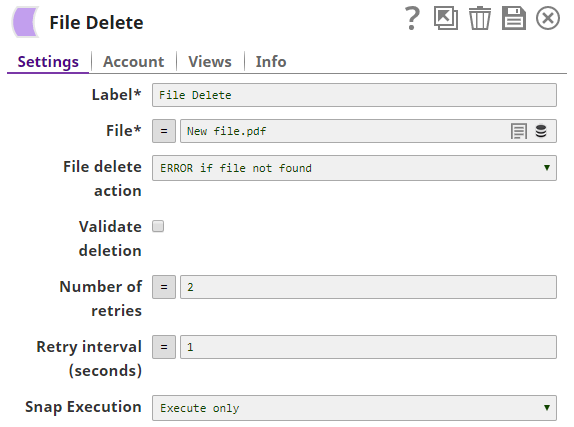On this Page
Snap type: | Write | |||||||
|---|---|---|---|---|---|---|---|---|
Description: | The File Delete Snap deletes a file in the SLDB, S3, FTP, SFTP, FTPS, WASB, WASBS, GS, and SMB protocols.
| |||||||
| Prerequisites: | None. | |||||||
| Support and limitations: | Works in Ultra Task Pipelines. | |||||||
| Account: | This Snap supports a Basic auth account, an AWS S3 auth account, SSH Auth account, SMB account, or no account. See Configuring Binary Accounts for information on setting up accounts that work with this Snap. | |||||||
| Views: |
| |||||||
Settings | ||||||||
Label | Required. The name for the Snap. You can modify this to be more specific, especially if you have more than one of the same Snap in your Pipeline. | |||||||
File | Required. Specifies the URL for the file to be deleted. It might start with a file protocol. The supported file protocols are SLDB, S3, FTP, SFTP, FTPS, WASB, WASBS, GS, and SMB protocols. Default value: [None]
| |||||||
| File delete action | Specifies the action that the Snap must take when the target file is not found during a file delete attempt. Select from the following options:
Default value: ERROR if file not found | |||||||
Validate deletion | If selected, the Snap checks if the deleted file still exists. Default value: Not selected | |||||||
| Number of retries | Specifies the maximum number of retry attempts in case of a network failure.
Default value: 0 | |||||||
| Retry interval (seconds) | Specifies the minimum number of seconds for which the Snap must wait before attempting recovery from a network failure. Minimum value: 1 Default value: 1 | |||||||
| Advanced properties | Use this field set to define additional advanced properties. This field set contains the following fields:
| |||||||
| SAS URI |
| |||||||
Default Value: Execute only | ||||||||
Example
Deleting a File from Your SnapLogic Database
The following pipeline describes a File Delete Snap that deletes a file from your SnapLogic database. The pipeline:

- Reads a file from your SnapLogic database using the File Reader Snap.
- Writes/Creates a new file in your SnapLogic database using the File Writer Snap.
- Passes the filename field to the File field of the File Delete Snap using the Mapper Snap.
- Deletes the newly created file, using the filename parameter, from your SnapLogic database using the File Delete Snap:

Similarly, in the above example, you can directly pass the filename in the File field of the File Delete Snap:

The following File Delete Snap deletes a file that exists on an external server. You must link the File Delete Snap with a valid user account and ensure that the user account has the appropriate privileges to delete a file from an external server. In the following pipeline, the File Delete Snap uses valid FTP user account credentials to delete the test.csv file:
